FAQs about Naso lituratus Pathogenic Disease
(plus see
Tangs/Rabbitfishes &
Crypt),
FAQs on Lipstick Tang Disease:
Lipstick Tang Disease 1, Lipstick Tang Disease 2, Lipstick Tang Disease
3, Lipstick Tang Disease
4, Lipstick Tang Disease ,
FAQs on Lipstick Tang Disease by Category:
Diagnosis, Environmental,
Nutritional, Social,
Trauma, Genetic,
Treatments
Related Articles: Lipstick Tangs, Naso
Tangs, Surgeonfishes/Tangs/Doctorfishes and Marine
Aquariums,
Related FAQs: Lipstick Tangs 1, Lipstick Tangs 2, & Lipstick Tang Identification, Lipstick Tang Behavior, Lipstick Tang Compatibility, Lipstick Tang Selection, Lipstick Tang Systems, Lipstick Tang Feeding, Lipstick Tang Reproduction, & Naso Tangs 1, Naso Tangs 2, Naso
Tangs 3, Naso ID, Naso Behavior, Naso Compatibility, Naso Selection, Naso Systems, Naso Feeding, Naso Disease, Naso Reproduction, Surgeons In General, Tang
ID, Selection,
Tang
Behavior, Compatibility, Systems, Feeding, Disease,
|
|
Surgeonfishes: Tangs for Marine Aquariums
Diversity, Selection & Care
New eBook on Amazon: Available here
New Print Book on Create Space: Available
here
by Robert (Bob) Fenner |
 |
|
Naso tang disease question
1/25/16
Hi,
<A few hundred Kbytes of clear pix; better than 6.5 Megs....>
My Naso has been looking like this for about a week.
<Not good.... either excess body mucus (likely rather than pathogens) or a
latent infestation at play here. What re water quality tests, the history of the
set up, other livestock present. You know, data of use>
Just today he seems more lethargic and not really eating..... I do have
ich in the tank
<Oh! Am reversing my opinion. This IS likely Crypt or other Protozoan>
but it is under control. Please let me know if you have any questions.
<Just the ones above.... Why such large files, lack of information.... Keep
READING:
http://www.wetwebmedia.com/crypttangs.htm
and the linked files above. Bob Fenner>
Thank you!
|
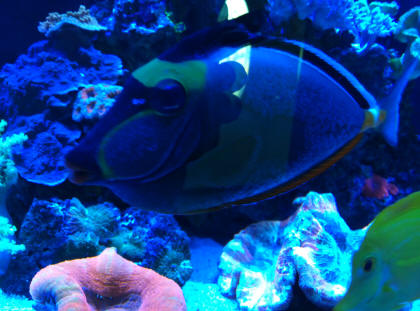
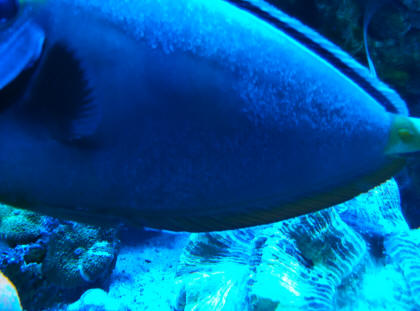 |
re: Naso tang disease question 1/25/16
Thank you! Were you able to see the pics?
<Yes>
Water quality is good.
<.... stop; subjective evaluations are of little use. NEED DATA>
All corals and other fish look fine. Hippo tang gets an ich spot here or
there. Naso is still eating but with less enthusiasm..... I have encountered
ich many times and this simply doesn't look like it......I was thinking
velvet, is
that possible?
<READ where you've been referred to. BobF>
re: Naso tang disease question
1/26/16
Thanks.
Temp 78.6
Salinity 1.025
Nitrate 10 ppm
Ammonia 0
Nitrite 0
Calcium 420
Alkalinity 8.4
Magnesium 1200
Ph 8.3
<These are good values en toto. Cheers, B>
|
|
16/02/10 Naso Tang disease
Hey guys
<Hello Antonis>
just found this Naso tang in one crappy LFS and I felt so sorry
about him when I realised that the LFS didn't know what was
wrong with it or how to treat it.
<Have you left this fish in the shop or taken it home? Never
take sympathy on a fish, it just encourages shops to peddle bad
specimens>
He told me I could have him for 15eur if I knew how to treat this
poor fella and I so much want to rescue him if I can with your
help of course! I don't know the guys parameters
<it would be very useful to find out>
but I know that the Tang has been this way for almost 2 weeks and
these reddish/whitish ''wound'' marks have gotten
bigger since he got him although he fed him at the time I was
there and the Tang was eating like a pig. I hope you can help my
when you look at the pics champs.
<Are these wounds or lumps? This looks like Lymphocystis to
me, not particularly concerning. Read here:
http://www.wetwebmedia.com/lymphfaqs.htm. Nothing you can do if
it is, the fish should recover on it's own without medication
if good care is taken of it>
Thank you very much,
<No problem>
I hope for your prompt reply, if you need anything else please
just ask,
<Do let us know the water test results, with the fruits of
your research into this>
Antonis
<Cheers, Simon>
Re: 16/02/10 Naso Tang disease
Thank you very much Simon for your prompt reply :o)
<No problem Antonis>
No of course I haven't taken it home with me it's still
at the LFS. I just thought to take some action in order for this
fella to recover because the man at the LFS is over 60 years old
and I don't think he can use the internet.
<Heee! Like my mother in law!>
And yes these were lumps not wounds. The spots were growing on
top of the surface of it's tail and the colour was mainly
white with a bit pink/red in the middle as you can see from the
pics and the white stuff's appearance was like fungus I
think!
<Yes, this does sound like Lympho to me. Search re. and see if
the images coming back match! Simon>
|
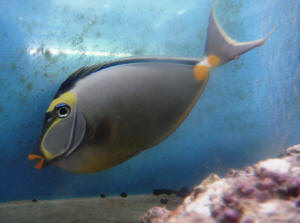 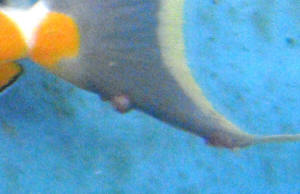 |
|
Re: 16/02/10 Naso Tang disease
2/16/10
<Hello Antonis>
I think so.
<Yes, me too>
Although most pics I can find the lumps are mostly white and not
reddish like the Naso I showed you.
<They do go this pinkish colour sometimes>
Why is it getting bigger though? Poor water conditions?
<I do think it is related to poor water quality, as many
things are. Improved conditions should see a halting and reversal
of this. Simon>
Re: 16/02/10 Naso Tang disease
It can clear entirely Simon?
<Yes it can Antonis. Good luck>
|
|
Re: worm, Naso QT, Protozoan fecal presence
2/1/09 Thanks for the compliments! Coincidentally, I
have a Naso tang in quarantine (for the past 4 weeks) that
stopped eating today. I noticed white hard fecal matter and
decided to look at that under a microscope. Well I saw (pics
attached) of something, possibly parasitic. Could you help
identify? <Mmm, other than appears Protistan/Protozoan, no...
but could be a commensal...> The Naso appears to be behaving
otherwise normally. The various pics are all pics of the same
thing. Thanks again! <I would not be overly concerned re
this... I would go ahead and place this Tang... as it is likely
to decline in the present small QT, and unlikely to infest the
DT. Bob Fenner>
|
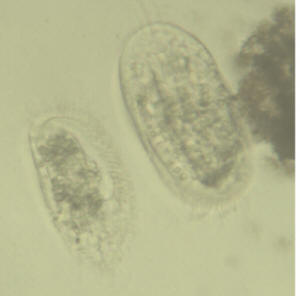 Ciliates at
400 X Ciliates at
400 X |
| Re: worm 2/1/09 I'm a bit hesitant to put
him in the DT b/c he did have Amyloodinium (verified
microscopically). <Mmm... okay> Treated with Chloroquine
diphosphate for 10 days. He's been doing well 4th day into
treatment and been doing well for the last 8 day post treatment (so
he's been doing well for 12 days) up until yesterday. Is it too
soon to put him into DT? thanks <Given this further data/input,
it is too soon. BobF> |
Naso Tang - Possible Ich? 04/05/2008 Hey guys,
how's it going. <<Hello, Andrew today>> I was just
going through your website and trying to figure out just what's
going on with my Naso Tang. I have had it for about a month and a half,
and am keeping it in a 55 gallon tank (I didn't do my research
prior to the purchase, but figured that I might keep it until there are
size issues). Anyways, the other day I came home, and my roommate
pointed out that there were white spots on the side of it. Immediately
I feared Ich, given the white spots and horror stories that I've
heard. But then under further research it seems unlikely that it could
be Ich. I have not introduced anything new to the tank in quite some
time, and it's behaviour seems to be quite normal. It's
breathing is regular, and feeding is normal as well. The white spots
are about 10 or so in number, and could be compared to the size of an
uncooked grain of rice. They are also definitely beneath the skin.
I've read that this is actually a characteristic of the tang,
however I do not feel fully convinced that I should pass on treatments.
So if there is any information you can offer me, or anything you can
tell me to be keeping an eye out for, it would be much appreciated.
<<Sounds like Ich to me, treat with hyposalinity. More can be
read here including the linked articles and FAQ's
http://www.wetwebmedia.com/ichart2mar.htm >> Thanks a lot,
Anthony. <<Thanks for the questions, hope this helps. A
Nixon>> <Mmm, much more likely embedded worms, possibly
Microsporideans... Not really treatable nor too debilitating. But...
this fish will likely perish in this too-small setting. RMF>
Re: Naso Tang - Possible Ich? 04/07/2008 They
don't seem like the regular sort of spots that Ich produces.
They're much bigger, and seem to come and go. Do you know anything
about the Naso Tang having such spots on it? Is this a characteristic
of the fish? And given that it has none of the other symptoms, and I
haven't introduced any new livestock to the tank in quite some
time, could Ich be eliminated as a possibility? Sorry if it seems like
I am refuting your far more knowledgeable opinion, but I'm just
looking to be convinced either way. Thanks again. <<It does sound
like Ich to me as these are very prone to this parasite. Their body
should be nice and smooth. Please do read more here. If you can provide
a close up photograph of the spot(s), then that would great.
http://www.wetwebmedia.com/naso.htm >> <<Thanks for the
follow-up. A Nixon>>
Naso Tang behaviour... hlth.
12/11/07 Hi Bob, <Chris> I have a Naso Tang - apprx 5"
for 3 months now. Feeding him different algae formulas blood worms and
Mysis shrimp soaked in vitamins and garlic. Occasionally gave him
lettuce <I wouldn't... no real food value, and too likely a
source of unwanted nutrients added to your water> He was always fine
and hungry --- 2 days ago he stopped moving around the tank (which he
always did) and is sitting in the corner behind live rock. <A very
bad sign> He does not eat any more and gets out only at night. He is
getting skinnier. <Yikes> I have 155 gallon reef tank where he is
the biggest fish (others are several clowns, 2 athias,3 fire fishes, 1
dragon goby,4 Chromis, 2 blood shrimp, Blue cheek trigger (very
peaceful) <Maybe...> I have my own versions 1. I noticed that I
have long worm in my aquarium (similar to tube worm) - could he harm
fish? <Mmm, no> 2.Trigger is attacking Tang behind my
back???(never noticed any tricks from him) <Possibly> 3.
Something to do with water quality --- I had my nitrates in their 20
lately Best Regards Chris <I have another item to add... there is
some good chance this fish has luminal problems... either a loss of
useful organisms (like termites) or parasites there. I would treat the
fish (perhaps in the main system in this case, circumstances) with a
vermifuge and protozoacide (Prazi and Metronidazole). Please see WWM re
their use. Bob Fenner>
Ich, another parasite, or stress??? I recently purchased a
Naso tang that appears to Ich, but I'm not sure (I'm new to
this). The Tang had a few white spots which now only really appear when
the fish turns a darker shade of grey. What concerns me is that it now
has some white patches on it, as if it has been scratching. I have
started to treat it in a separate tank with Melafix and CopperSafe, I
have also given it a fresh water dip. I have noticed that it has not
eaten anything in several days. Is there anything else I can do?
Thanks, Kyle <Maybe. I would lower the specific gravity and stop the
Melafix. Please read over the Ich, treatment, tang, tank
troubleshooting... sections of our site: www.WetWebMedia.com, starting
here: http://wetwebmedia.com/tanktroubleshting.htm Bob Fenner>
Re: Ich, another parasite, or stress??? Thanks.....I am new
to saltwater tanks and have been informing myself as quickly as
possible through websites and local fish stores. Regretfully the Naso
didn't make it and the specific gravity is really high, so I'm
slowly going to lower that. Thanks for the help and all the info on the
webpage. <Mmm, good to learn through as many inputs as practical...
be chatting Bob Fenner>
Ich Life Cycle,,, adventures of Naso Hey Bob, I read about
the Ich cycle a bit more and came across some info about the Cyst
encased in gelatin stage.... <Yes> I believe I saw one a long
time ago.... <Not visible to the "naked eye"> I thought
that it was just mucus released by one of the corals.... So could this
have been a Cyst at the bottom of my tank? It is/was about 1/2 an inch
in diameter max. Is it safe to suck it out during a water change every
time I see one? I have seen one on 2 separate occasions.... about 2
weeks ago and say 5 weeks ago....Knowledge.... there is no
substitute..... Again your guidance is very appreciated, Robert PS. Do
the cleaner shrimp eat Ich in the Tomite stage or cyst stage? <They
consume the encysted stages minimally (and necrotic tissue, mucus...)
on the fish hosts only. Bob Fenner>
Re: adventures of Naso DOH!!! <No more Simpson's for
you> I am getting used to the type of contradictions.... I hate that
I had to learn the hard way like most people. <Not necessary, as you
know> Found this... they say not good for reefs.... I am still in
your camp... they gave no reasons WHY!!! Hyposalinity- This treatment
cannot be done in a reef tank with invertebrates, live sand or live
rock. Hyposalinity is at 16ppt, is highly effective at eliminating Ich
and surprisingly low stress. . This may be the best therapy as it is
not a dip but rather a long-term bath that should last a minimum of
three weeks. The treatment is more effective (although copper can be
very effective) and less stressful than copper treatments. The only two
disadvantages to using hyposalinity verses copper is an accurate
hydrometer is need (or refractometer is even better) and you need to
check the pH and alkalinity daily and add buffer as needed. Most
hydrometers are inaccurate. You need one calibrated for reef temps and
some large glass types are O.K. Stay away from plastic swing arm
hydrometers they are not often accurate. Hyposalinity will NOT disrupt
the biological filtration as long as the salinity is not lowered too
abruptly. If you lower the salinity using two water changes a day for
two days the bio-filter will be fine. The bacteria that perform
biological filtration are the same in FW or SW all you have to do is
acclimate them to the change When you are ready to introduce your fish
raised the salinity back up to normal over the course of a few days to
keep the fish from stressing from a quick change in salinity. <Some
factual, other fictional material... Bob Fenner>
Black spot (markings on a Naso Tang) Bob, Just to confirm.
I'm pasting your description below. Yesterday, we had what looked
like tiny white spots that disappeared and moved around like bubbles
just in front of the lower/ventral fin. Now it looks like a fine black
powder on the ventral/bottom fin of our Naso tang. If this is
"black spot" you suggest fresh water dip. It doesn't look
like a worm (I think someone called it a small ciliated protozoan?)
Dakin says it can spread to the gills and they can suffocate. How long
do we have before this happens? <What? Do you have access to a
microscope? I would scrape off some of these "black spots"
and take a closer look... they are not ciliated Protozoans (e.g.
Ich)... these are too small to see with the "naked eye"...
and moving about?> The fish is visiting the cleaner shrimp (they
don't look too interested). Perhaps this will go away? It's
weird because within the first hour the fish was awake, it looks like
some of it has disappeared (not all of it). It always seems that
diseases are worse in the morning...is that because the cleaner shrimp
pick things off during the day? Treatment: Freshwater dip: adjust pH
(w/baking soda), temp, truly FRESH water or should we just have a
slightly lower specific gravity (e.g.1.019)? Additives to dip: Copper
we've got Cupramine--what concentration?.2?)--perhaps some
Methylene blue? Formalin? Do any of these things interact? If we have
to choose, which is the most useful and least toxic to the fish? 2-10
minutes? Should the black spot disappear during this time? Should we
just do it for 10 min or as long as the fish can tolerate? I suspect
he'll freak out regardless.--some aeration Should 1 dip suffice?
We've been getting Caulerpa and trying to grow it from a
friend's tank. Do you think that might have transported it?
He's got a yellow tang but it looked great. One notable
exception is Para vortex, the causative agent of "black spot
disease", notably of yellow tangs. This is easily eliminated via
freshwater dipping, though other authors suggest formalin baths and
organophosphate remedies. Turbellarians, a group in the flatworm Phylum
Platyhelminths are mostly "free-living" non-parasitic
species. Thanks, Allyson <This is not Paravortex... on a Naso
Tang... maybe a trematode/fluke... I wouldn't necessarily
"treat it" unless symptomatically this condition seemed to be
seriously negatively impacting this animals behavior. Bob
Fenner>
Surgeonfishes: Tangs for Marine Aquariums
Diversity, Selection & Care
New eBook on Amazon: Available here
New Print Book on Create Space: Available
here
by Robert (Bob) Fenner |
 |
|
|

